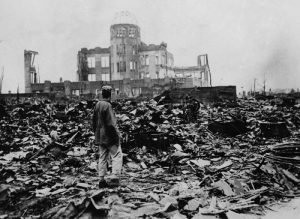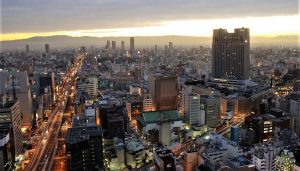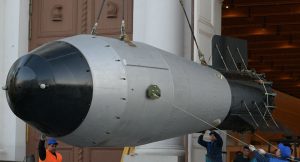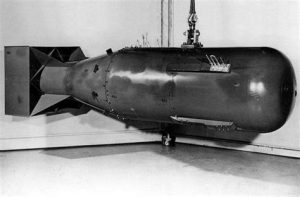Since Auschwitz, we know what man is capable of. And since Hiroshima, we know what is at stake. (Viktor E. Frankl)
On August 6, at 8:16:02 in the morning, after falling nearly six miles in forty-three seconds, the first nuclear bomb to be used in warfare, Little boy, explodes just above the Aioi Bridge in Hiroshima, Japan, and the world was unalterably changed. In a matter of microseconds, a large-scale obliteration moving at 984 miles per hour consumes everything in a thousand-foot diameter as a nightmarish synthesis of 7,000° F air vaporizes, melts, and burns everything standing in its way. Human and animal flesh and internal organs are evaporated, and 60,000 buildings collapse or are stripped of their patina, leaving skeletal remains glowing from the superheated air like a freakish scene out of a macabre Halloween nightmare.
The blast releases shock waves in a monstrous concussion that reverberates in the surrounding Chūgoku Mountian Range, likely drowning out the cacophony of screams of horror. Those who were not in the direct blast zone were not spared either, as ionized air caused wide-spread radiation poisoning and survivors began to uncontrollably vomit.
When Ryoga Suwa, whose sister died in the bombing, returned to his neighborhood 40 days later, he described “what remained of the property was a cluster of overturned tombstones from the temple cemetery. . .Hiroshima was a flat wasteland.” Nagasaki, just 260 miles to the southwest of Hiroshima, endured a similar nuclear fate three days later.
When it was all over, nearly 200,000 people were dead, countless were injured or ill, and two cities lay in ruin, testimony to the awful destructive power humankind is capable of when scientific genius is merged with desperation, fear, and retribution. Seventy-six years later, Hiroshima, despite the pandemic, “. . . is a prosperous manufacturing hub with a population of over 1.1 million” people who call it home.

Nagasaki has also recovered, powered by tourism and a thriving port which plays a key role in Japan’s industrial commerce. But the scars are still deep and wide.
I do not write this as a condemnation of these acts by the United States. We were at war, and I am fully aware of the atrocities committed by the Japanese military against our POWs and perpetrated against the people they conquered in their quest for world domination. Moreover, there would have been a staggering cost to human lives, especially American soldiers, had we opted to invade mainland Japan with ground forces. I am also aware of plans by the Japanese government to create their own set nuclear of nuclear weapons to unleash on the West.
And there is the “deterrence” theory that if we had not dropped the bombs on Japan, we would not have learned the totality of the destruction and carnage, leading us to potentially commit global thermonuclear genocide at the height of the cold war. Fair enough. Ultimately, this is an ethical argument each person has to decide on their own, and if we have learned anything from our collective reaction to 9/11 (ironically the last time Democrats and Republicans were united), judging history with modern eyes is a myopic exercise at best anyway.
However, on this 76th anniversary of the saddest day in history for Hiroshima’s citizens, I do ask that we learn something from this particular horror. Once again, we are ratcheting up the call for nuclear proliferation, this time in the form of escalating tensions with Russia and the new, most aggressive player, China. According to the Federation of American Scientists (FAS), the United States has 5,550 nuclear weapons in its arsenal, followed by Russia’s 6,257 and China’s 350.
Furthermore, The International Campaign to Abolish Nuclear Weapons (ICAN) estimates that the top nuclear powers, including the United Kingdom, France, China, India, Pakistan, Israel and North Korea “possess an estimated total of nearly 14,000 nuclear weapons,” even as the United States, Russia, and China plan for, or are in the process of, making more.
There seems to be a pervasive attitude that nuclear weapons are the path forward. ICAN points to the fact that beyond the top nuclear powers, “Twenty-six countries (plus the five hosts) also ‘endorse’ the possession and use of nuclear weapons by allowing the potential use of nuclear weapons on their behalf as past of defence alliances, including the North Atlantic Treaty Organisation (NATO) and the Collective Security Treaty Organisation (CSTO).”

Of course, on a technical level, we have as a global community, significantly decreased our nuclear arsenal. The FAS states the “. . .number of nuclear weapons in the world has declined significantly since the Cold War: down from a peak of approximately 70,300 in 1986 to an estimated 13,100 in early-2021.”
However, these numbers are highly deceptive because the nuclear weapons we have available today are vastly more powerful than the ones used on Hiroshima and Nagasaki. Russia’s capacity alone is frightening, as reported by Popular Mechanics:
It gets even more terrifying than that. The largest nuclear weapon ever detonated, the Tsar Bomba, set off by the Soviet Union in 1961, produced an insane 50-megaton blast—about 3,333 times more powerful than the Little Boy bomb that leveled an entire city. The Tsar Bomba is the largest manmade explosion to date, sending a mushroom cloud up to more than 130,000 feet in altitude—about 4.5 times the height of Mount Everest—as it sent shockwaves around the globe three times over.

And the nuclear capacity of the United States is equally terrifying. Consider this: The explosive yield of a nuclear weapon is typically measured in kilotons of energy release. Little Boy and Fat Man, the bombs dropped on Hiroshima and Nagasaki, respectively, had a collective energy yield of 36 kilotons of energy (15 for Little Boy and 21 for Fat Man).
By contrast, the bomb used in Castle Bravo On March 1, 1954, at Bikini Atoll in the Marshall Islands was a 15 megaton explosion, which is 15,000 kilotons, or nearly 500 times more powerful than Little Boy and Fat Man. Roughly speaking, that means we would have had to drop the equivalent of approximately 1,000 Little Boy or 715 Fat Man warheads. That was just one bomb, so let that sink in for a moment.

Our modern reality is not much better. The B83, the United States’ most powerful nuclear bomb in our arsenal, has a 1.2 megaton yield, which according to military.wikia.org is “75 times the yield of the atomic bomb Little Boy.” And although estimates vary as to the quantity the United States still has at its disposal, the Los Alamos Study Group states, “Unless some have been dismantled in the last decade there could be more than450 strategic B61-7/11s, many (all?) of which have through a life-extension program and as many as 600 B83s, at least half of which have been through a life-extension upgrade to become B83-1s.”

The type of atomic bomb that was used in Japan in World War II, known as the “Fat Man,” is shown here in a 1960 photo released by the U.S. government. Liberals and conservatives are gathering at the Ronald Reagan Presidential Library on Tuesday to call for efforts to eliminate nuclear weapons.
Due to the secretive nature of China’s government, it’s difficult to gauge what specific types of nuclear warheads they have, and therefore their energetic capacity. However, the most powerful nuclear bomb China ever dropped was a 4 megaton warhead in 1976, meaning it was nearly 200 times more powerful than Fat Man and 266 more powerful than Little Boy.
And while it was impossible for me to determine the collective energy of all the world’s nuclear weapons, if we take ICANS estimate of 14,000 nuclear warheads in developed countries, and assigned 1 megaton value to each (likely a significant underestimate), that equates to a yield of 14,000,000 kilotons of energy, which would be equal to roughly 1,000,000 Little Boys or 667,000 Fat Mans.
In reality, calculating just the nuclear explosive energy is misleading, because there are other factors that may matter more. Shannon Kile, program director on the Nuclear Disarmament, Arms Control, and Non-proliferation program of the Stockholm International Peace Research Institute (SIPRI), puts it into perspective, saying, “The destructive impact of modern thermonuclear weapons is difficult to calculate. This is because the explosive yield of the weapons may vary depending on the military role and mission.”
Building on this argument, the head of the Weapons of Mass Destruction program for the UN Institute for Disarmament Research (UNIDR), John Borrie, warns, “Overall, nuclear weapons today are much more sophisticated and flexible than those in 1945. But an important variable not to be forgotten is that of the vulnerability of the target. There is some evidence that in today’s much more interconnected world, the use of a single nuclear weapon in a highly-populated area could cause global disruption far beyond the direct death and injury it causes.”
Globally, it does not look like we are doing anything constructive to stave off nuclear Armageddon. As the FAS puts it, “Instead of planning for nuclear disarmament, the nuclear-armed states appear to plan to retain large arsenals for the indefinite future, are adding new nuclear weapons, and are increasing the role that such weapons play in their national strategies.”
Of course, there is always the military doctrine of Mutually Assured Destruction (MAD) that may save the day, the “idea that one’s population could best be protected by leaving it vulnerable so long as the other side faced comparable vulnerabilities.” Wrung from the ideology of cold-war nuclear escalation, the saving grace would be “whoever shoots first, dies second” an acerbic observation made by former President of the Soviet Union, Nikita Khrushchev.
Perhaps ironically, given his part in the build-up of nuclear weapons during the 1980s, President Ronald Reagan’s words ring truer than ever: “A nuclear war cannot be won and must never be fought.” Echoing this sentiment, Hiroshima Mayor Kazumi Matsui observed the 76th anniversary of the bombing of his city by saying, “Nuclear weapons, developed to win wars, are a threat of total annihilation that we can certainly end, if all nations work together.”
Let the work begin.






